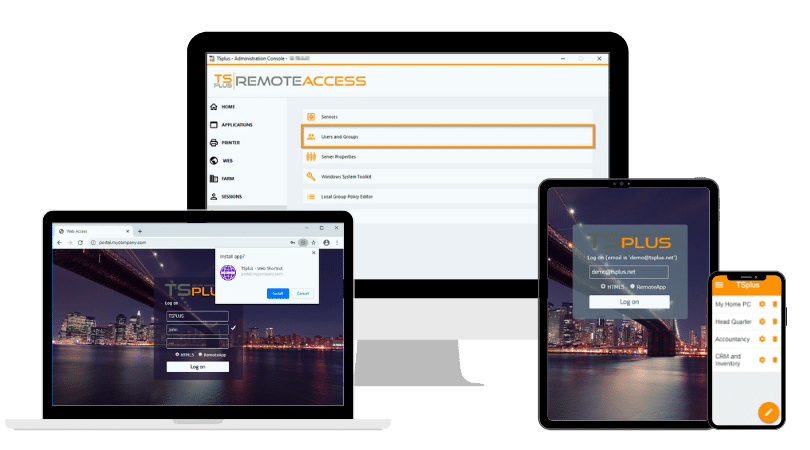)
)
Ever tried to
print locally from a remote desktop session
If you have, you already know the relief when it works as expected. You will also know that
printing documents from a remote desktop session to a local printer can be surprisingly tricky. Indeed,
Remote printing is unfortunately too rarely as simple as it should be.
So, starting with Microsoft Remote Desktop Protocol (RDP) tools before progressing to solutions like TSplus, here
are the standard steps to
help you resolve remote printing issues and simplify your workflow
.
Why Remote to Local Printing Matters?
Remote work has become the new standard for businesses worldwide. Whether employees are working from home, travelling or simply using a different office, accessing office systems via Remote Desktop sessions is now routine. However, printing locally from such sessions can be complex, especially when dealing with company-specific printers, drivers or security protocols.
In this section, explore with us why remote-to-local printing plays such a critical role in today’s work environment, including:
- Benefits
- Common Use Cases
Advantages of Local Printing
Convenience:
- Local printing from a remote desktop session allows users to instantly print documents without the need to download or transfer files manually. This ensures smooth workflows, especially during time-sensitive tasks.
Security:
- By printing locally, sensitive documents remain within the secure environment of the user’s physical location, reducing the need to use external or cloud-based printing services that could present data risks.
Efficiency:
- Employees can avoid lengthy troubleshooting or contacting IT support just to print a document. A properly configured remote-to-local printing process minimises downtime and frustration.
Compliance:
- Certain industries such as healthcare and finance require local storage and printing to meet regulatory requirements like HIPAA or GDPR.
User Satisfaction:
- A seamless printing experience boosts employee productivity and satisfaction, especially in hybrid and remote work environments.
Common Use Cases for Local Printing
- Printing labels, invoices or reports from a remote ERP or accounting system.
- Generating signed contracts and shipping documents during remote support sessions.
- Printing HR documents, training materials, or internal reports while working from home.
- Accessing specialized printing tools, such as barcode or label printers, from a remote factory floor or warehouse.
- Printing customer orders and receipts from a Point of Sale (POS) system during remote retail operations .
This useful potential of printing from a local device to a local printer even when using a networked session has great applications. Now to make sure you are all set up.
How to Print Locally via Microsoft Remote Desktop?
To print to your local printer from a Remote Desktop session using Microsoft's native RDP client:
Set Up Step-by-Step with Microsoft RDP
- Open Remote Desktop Connection (mstsc.exe) on your local device.
- On the local PC, open Remote Desktop Connection (RDC).
- In the remote workspace, click "Show Options".
- Click "Local Resources".
- Under Local devices and resources: Check the "Printers" box.
- Go back to the “General” tab and click Save Settings.
- If necessary, make sure this has been applied by restarting.
Press Print
These settings should now be automatic for subsequent uses. Test them if need be, or go ahead and print:
- Connect to the remote session. Your local printer should now appear in the remote system’s printer list.
- Select the printer and click Print.
NB: it is always worth remembering that, whenever you log off your session or disconnect from it, the print queue will be deleted, and any incomplete or pending jobs will be lost.
How to Troubleshoot Common Remote Printing Issues
With remote work and flexible office habits, printing to our home printer, a few steps away from our home workstation, can nonetheless be surprisingly complicated from a remote session.
What if my Local Printer is not Visible in my Remote Desktop Session?
Since even if you know it should be visible, your local printer may not be in the list Below is a checklist. Indeed, there are a few considerations in this case, starting with one you may brush off initially but which is actually the best place to begin.
At home, regardless of having suitable permanent office space or not, cables may be played with by small hands, paws, etc. or simply less well plugged in than they need. So: Is the local printer plugged in, switched on, not idle?
Here are the first batch of items to tick off:
- Check physical connections Ensure the printer is powered on and connected properly.
- Verify driver compatibility Some printers require the same driver on both local and remote machines.
- Check group policies Administrators may block printer redirection via Group Policy settings. NB: Group Policy settings for printer redirection may prevent local printers from appearing if misconfigured or blocked on the remote server. Check with your administrator.
- Ensure correct network configurations Local printers need to be USB or locally connected. Nevertheless, some of these network printers will still not be redirected.
- Restart session and device after changes.
Of course, it may be that problems persist or you need external intervention.
Related Questions Surrounding Printing Issues In Remote Sessions
Here are, in no particular order, further important questions to consider :
- Can you fix this yourself?
- Do you rely on an administrator or technical support person? What information (name of your computer, its IP address, printer ID…) might they need?
- Does my local printer require a compatible driver not available on the remote computer? Often, the same print driver needs to be installed on both the local and the remote desktop systems so your printer can appear locally over your Remote Desktop session.
- Do you need to install an older driver supported by both computers? Then probably manually redirect printing.
- Is your printer networked? It needs to be locally connected for the RDS to access it. Redirection will need setting up should the standard protocol fail to manage a USB printer.
How to Overcome RDP Limitations?
While Remote Desktop Protocol (RDP) offers built-in printer redirection, it is sometimes insufficient, especially in complex modern work environments. Even after following all basic setup steps, you may still face unexpected issues preventing successful local printing.
This section dives into advanced methods for addressing remote printing challenges, such as:
- Why Printing Fails Despite Correct Setup
- Solutions Beyond Branded Printer Drivers
Why Printing Fails Despite Correct Setup?
Several technical limitations can cause RDP printing to fail, even when configurations appear correct:
Driver Incompatibility:
Modern printers often require specific drivers that may not be available on older remote servers or virtual machines. Without matching drivers on both the local and remote systems, the printer may not appear or function correctly.
Unsupported Printer Types:
Certain specialized printers (such as barcode, receipt or label printers) are not fully compatible with basic RDP printer redirection. These devices often use proprietary drivers or protocols that RDP cannot handle.
Cross-Platform Printing Issues:
If you are accessing the remote desktop from a non-Windows device, such as macOS, Linux or mobile devices (iOS, Android), printer redirection becomes even more challenging. Many third-party Remote Desktop clients offer limited or no printer redirection support on these platforms.
Complex Network Configurations:
In some environments, firewalls or VPN settings may block the redirection of printer ports or services, especially when strict security measures are in place.
Solutions Beyond Printer-specific Drivers
Do you face persistent issues? There are several effective solutions, beyond simply using native or brand-specific printer drivers:
Install Universal Print Drivers:
Some printer manufacturers offer universal print drivers (UPDs) designed for compatibility across a wide range of devices. Installing these on both local and remote systems can sometimes resolve issues.
Leverage RemoteApps Instead of Full Desktops:
RemoteApp technology allows specific applications to run remotely but appear as if they are local programs. This method often simplifies printing and minimises the need for full desktop redirection.
Switch to Driverless, PDF-Based Printing Solutions:
Advanced solutions, like TSplus Universal Printer, bypass the need for drivers entirely by converting print jobs into PDFs. This ensures consistent, driverless printing, even across platforms and networks.
Consult IT Support for Network Configurations:
In corporate environments, IT administrators may need to adjust firewall settings, enable specific ports or modify Group Policy to allow printer redirection.
Combining these methods, you should have overcome any Remote Desktop printing limitations; however, you may simply want an alternative. Integrating simple, efficient printing tools into your remote network strategy can significantly improve workflow and reduce stress. Hence why TSplus Remote Access now includes printing solutions as standard, enabling you to access Windows remotely and print locally without the usual barriers.
What are the TSplus Printing Solutions?
TSplus provides three solutions for printing:
- Universal Printer
- Virtual Printer
- TSplus Printer Mapping
TSplus Universal Printer: Print as PDF Anywhere
The TSplus Universal Printer simplifies remote-to-local printing by automatically generating a PDF file of your print job during your remote session.
- It redirects the PDF to your local device instantly.
- You can view, save, or print it with any PDF reader like Adobe Acrobat.
- No drivers required on the remote server.
- Works on any device, including via browser-based remote access.
TSplus Virtual Printer: Direct Printing for Special Needs
For specialized use cases, the TSplus Virtual Printer:
- Creates a virtual printer in the remote session.
- Automatically maps to your actual local printer.
-
Supports advanced printer features such as:
- Special paper sizes
- Labels
- Barcodes
- Duplex printing
- Eliminates driver conflicts by routing print jobs through the TSplus connection client.
Understanding the relationship between virtual printer drivers and network printer configurations can be helpful for advanced setups, especially in remote desktop environments involving specialised or shared printers.
TSplus Printer Mapping
Should you still wish to map your printer through RDP within a TSplus Remote Access session, this is also possible. It is nonetheless worth remembering how RDP can cause incompatibility with certain specific printers.
Key Benefits of TSplus Solutions
Recent versions of TSplus Remote Access wield NovaPDF. First discover what that means in practice then we round up the greatest benefits of this development:
Partnering with Nova PDF for Greater Reliability and Full Compatibility
2024 saw printing compatibility enter a new era with our extended partnership with printing specialists
NovaPDF
The combined work of two skilled and inventive teams of developers and their support colleagues has provided a stable and efficient toolset for quick and easy printing from a remote desktop session.
The goal was to provide the most affordable, secure and hassle-free printing experience. Among other things, TSplus Virtual Printer driver and TSplus Universal Printer in their new shape make it possible to remotely print any document with your local printer, wherever and whenever you need to, including to demanding specifications of size and unusual dimensions.
Here are the individual advantages as a result of this:
Driverless Operation:
No need for local driver installations on remote servers.
Device Flexibility:
Print from Windows, Mac, iOS, Android or HTML5 browsers.
Fast Deployment:
Easy setup and configuration with minimal IT expertise.
High Compatibility :
Supports a wide variety of printers, including older models.
All of which streamline usability and flexibility.
Conclusion
Printing locally from a Remote Desktop session remains a vital capability for professionals and businesses aiming to maintain productivity in remote work environments. Whether you are accessing critical applications, processing invoices or simply printing documents for meetings, having a reliable, efficient way to print to your local printer is essential.
By understanding the common challenges with printer redirection, exploring both built-in and advanced solutions, and following best practices, users can ensure smooth, uninterrupted printing operations. Ultimately, solving remote printing issues enhances security, efficiency and overall workflow flexibility.

TSplus Remote Access Free Trial
Ultimate Citrix/RDS alternative for desktop/app access. Secure, cost-effective, on-premises/cloud














)
)
)